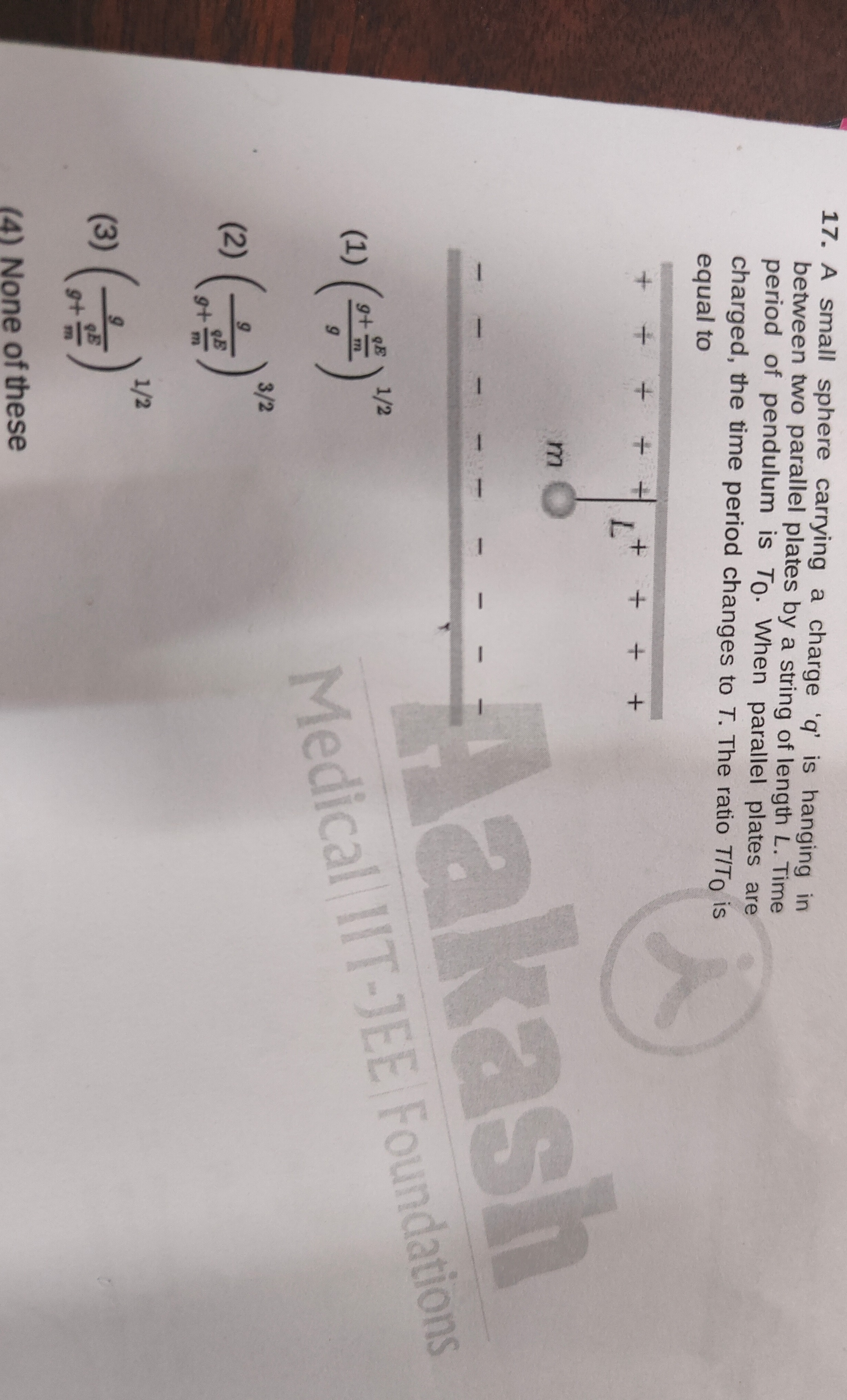Question
Question: A small sphere carrying a charge 'q' is hanging in between two parallel plates by a string of length...
A small sphere carrying a charge 'q' is hanging in between two parallel plates by a string of length L. Time period of pendulum is To. When parallel plates are charged, the time period changes to T. The ratio T/To is equal to

(g+mqEg)1/2
(g+mqEg)3/2
(g+mqEg)1/2
None of these
(g+mqEg)1/2
Solution
The time period of a simple pendulum of length L in a gravitational field with acceleration g is given by T0=2πgL.
When the pendulum is placed between charged parallel plates, an additional electric force acts on the charged sphere. Let's assume the electric field between the plates is uniform and vertical, with magnitude E. Let the charge on the sphere be q.
Case 1: Electric field is vertically downwards. The electric force on the sphere is FE=qE downwards (assuming q is positive). The gravitational force is Fg=mg downwards. The total downward force is Fnet=Fg+FE=mg+qE. The effective acceleration is geff=mFnet=mmg+qE=g+mqE. The time period in the presence of the electric field is T=2πgeffL=2πg+mqEL. The ratio T/T0=2πgL2πg+mqEL=L/gL/(g+qE/m)=g+mqEg=(g+mqEg)1/2.
Case 2: Electric field is vertically upwards. The electric force on the sphere is FE=qE upwards (assuming q is positive). The gravitational force is Fg=mg downwards. The net downward force is Fnet=mg−qE (assuming mg>qE). The effective acceleration is geff=mFnet=mmg−qE=g−mqE. The time period in the presence of the electric field is T=2πgeffL=2πg−mqEL. The ratio T/T0=2πgL2πg−mqEL=g−mqEg=(g−mqEg)1/2.
Case 3: Electric field is horizontal. The electric force is FE=qE horizontally. The gravitational force is Fg=mg vertically downwards. The effective acceleration is geff=g2+(mqE)2. The time period is T=2πgeffL=2πg2+(mqE)2L. The ratio T/T0=2πgL2πg2+(mqE)2L=g2+(mqE)2g=(g2+(mqE)2g)1/2.
Comparing the results with the given options, options (1) and (3) match the result obtained when the electric field is vertically downwards (assuming q is positive). Since options (1) and (3) are identical, it is likely that the intended problem involves a vertical downward electric field, despite the diagram showing vertical plates and thus a horizontal electric field. Or, the diagram is just a generic diagram for a pendulum between plates and the electric field direction is not implied by the diagram. Given the options, the scenario with a vertical electric field is the only one that yields a matching expression.
Let's assume the electric field is vertical and downwards. T0=2πgL T=2πg+mqEL T0T=2πgL2πg+mqEL=g+mqEg=(g+mqEg)1/2
This matches options (1) and (3).
The final answer is (g+mqEg)1/2.
The final answer is (g+mqEg)1/2. The option (1) and (3) are identical. Let's choose (1) as the answer.
The final answer is (g+mqEg)1/2.
